Today’s post is all about your questions about the Cassandra Stays. Can you use different types and widths of boning? Are stays or corsets more comfortable? Why five panels instead of four? Can you tell us more about tab width and shape? Do the Augustas or the Cassandra Stays work better with a short torso? And can the theatrical version be made without back lacing?
The Cassandra Stays Sew-Along is coming up in April! Watch out for more info about that in just a few days. For now, let’s answer your questions about the Cassandra Stays:
The Cassandra Stays call for 4mm boning. Can you use other boning widths?
You can use any boning width you want for the Cassandras, and use other types of boning too. Cane works great. We recommend against metal boning (really not comfortable, and very heavy) and cable ties (not comfortable and won’t last long).
We chose 4mm wide boning for the Cassandra pattern because all of the extant stays that we studied to develop the pattern were primarily boned with very narrow boning. The narrowest widely available synthetic whalebone width is 4mm. This width is the closest match to most of the stays we looked at, and really highlights the spectacular V shape of the bones meeting at the front of the stays.
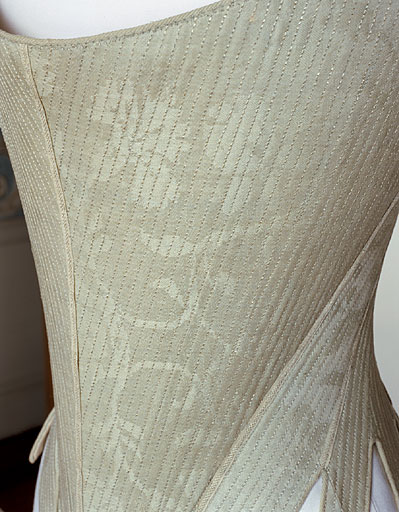
Pale blue glazed woollen damask over stiff foundation, lined with white linen. Bound with pale blue twilled wool, 1947.1622 Manchester Art Gallery
The narrow boning in the Cassandra pattern does mean that you have to sew a lot of lines of stitching for boning channels, and buy two different widths of boning, as the pattern calls for wider 6mm boning which frames the lacing holes. A mix of boning widths was also typical of the stays we studies.
If you want to sew less boning channels, can’t get 4mm wide bones, only want to buy one width of boning, or just want a different size for any other reason, you absolutely can use different bone widths in the Cassandra Stays. Just use the primarily boning lines (marked in black on your pattern) as a guide, and draw new boning channels in the width you want out from there.
Keep in mind that the sizing of the Cassandra Stays is calculated for the size and width of 4mm x 1mm bones. If you use wider or deeper bones you may find the sizing of the stays changes slightly. Always make a toile using the type of bones you want for your finished stays, and fabric that is as close as possible to your fashion fabric.
Are stays or corsets more comfortable?
That’s like asking if oranges or apples are the better fruit! Oranges are usually better if you want to make sorbet, apples are better if you want to make pie.
(OK, so it’s not a perfect analogy because you could certainly make apple sorbet, and there are orange based pies, but usually we use one for one thing and the other for the other. You get the idea though!)
First of all, there’s no true distinction between stays and corsets: we usually use ‘stays’ to mean boned bodices from the 17th and 18th centuries, and ‘corsets’ for boned undergarments from the 19th and early 20th, but historically corsets were originally unboned, and stays was used as a term for boned undergarments that we’d today call corsets well up until the 20th century. More about that here.
How comfortable any pair of stays or style of corset is on you is going to depend on how good the pattern is, how well fitted to you they are, what materials they are made out of, and your personal body type.
What I can tell you is that the feedback from the testers and the models is that the Cassandra stays are incredible comfortable.
We shot the sample photos (below) on a day with record-breaking high temperatures. The models were mopping their faces every 10 images. And at the end of it they were still marvelling at how comfortable their stays were, even in tropical swamp weather.
Why do the Cassandra Stays have five panels per side instead of four, like every available scale pattern of extant stays of this style available?
The answer is kind-of in the title! Although most of them are one-sized scale patterns that you have to draw up and make fit you, there are a number of patterns for stays similar to the Cassandras, but with only four panels. There’s one in Patterns of Fashion 5, and one in Stays, or a Corset?.
Amber studied a couple of pairs of Cassandra-type stays that had five panels. She realised there was a gap in what was available as a pattern. She also found that the extra panel allowed you to get an even better, more customised, fit than four panels.
So, something not already available on the market AND better fitting? What’s not to love!
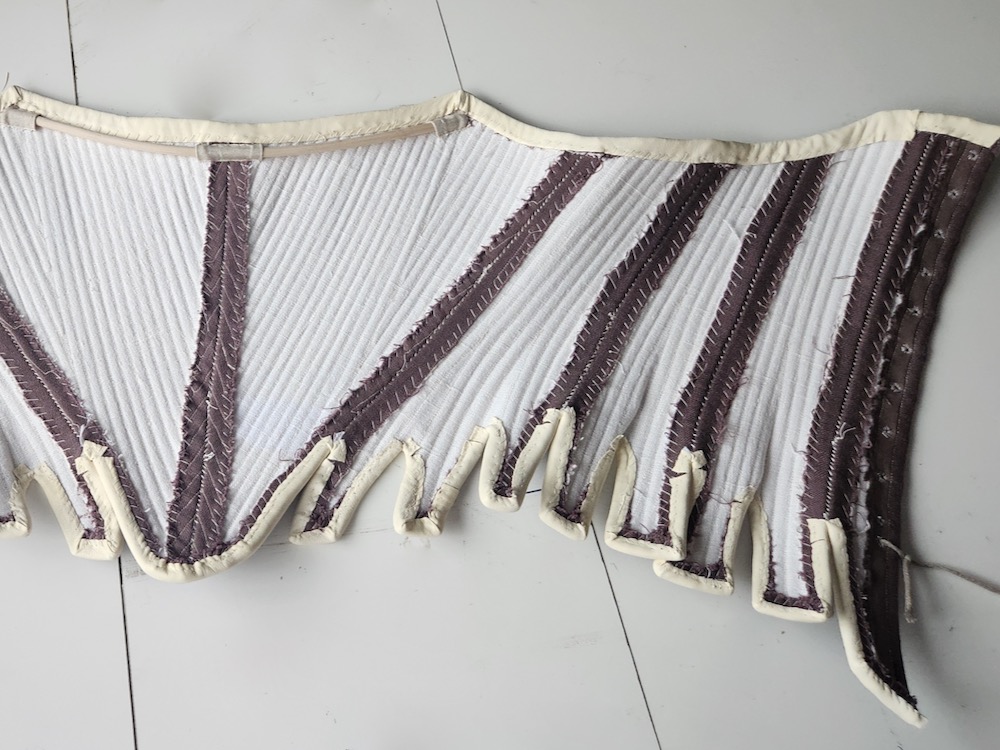
Leather bound stays by Jessica of @scotchirish1775
Can you tell us more about tab width and shape? Was round or square more common at certain times?
When we drafted the Augusta Stays pattern Amber chose a rounded V shape for the tabs, because she finds that easiest to bind around. With the Cassandras I asked it we could have a rectangular shape, because I find that easiest to bind round. Both shapes are well represented in the extant stays we used to develop both patterns.
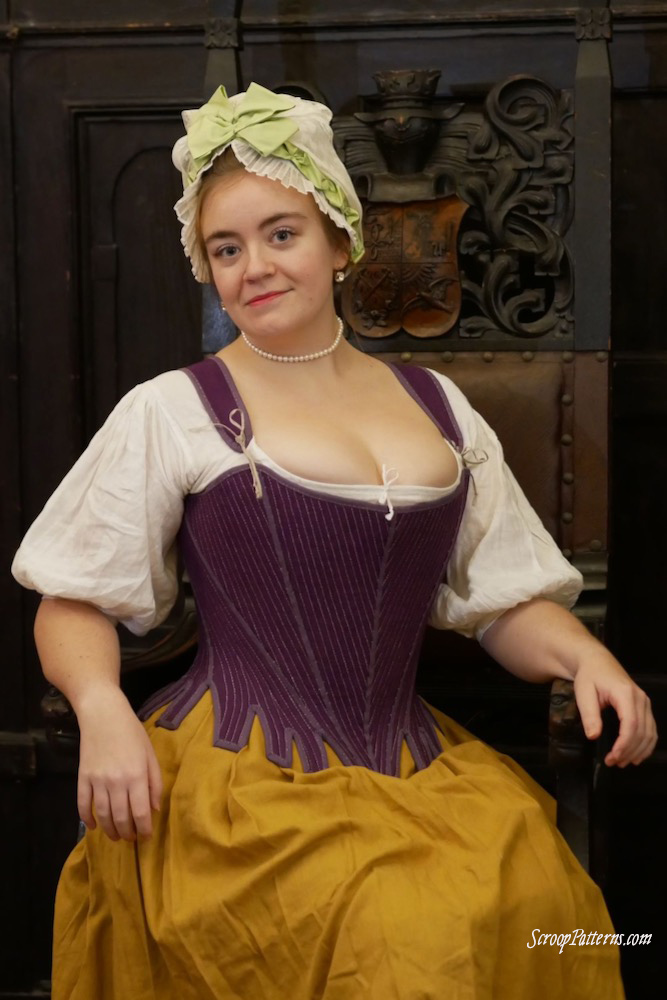
I’d have to do a comprehensive survey to see if one style was more prevalent in certain periods. However, a casual survey suggests tab shape was really just the maker or wearers preference, and wasn’t more typical of one decade or another.
Some people have commented on the width of the tabs, and I’m afraid that one of the test samples has mislead people. There are the same number of tabs on the Cassandra Stays across all the sizes, so the tabs of the stays do get wider and narrower with the size of the stays. However, the photo above is a little confusing. Those stays are bound in black, which disappears against the black skirt, making the tabs look like narrow little twigs. In reality they have an extra 1/2” of black binding all around them!
Do the Augustas or the Cassandra Stays work better with a short torso?
That depends on so many body shape factors besides torso length that we can’t answer that! But both patterns can be altered to work well with any torso length.
The fashionable silhouette for 1760-80s was for a longer torso, whereas the fashionable silhouette for 1780-90 was for a shorter torso. The Cassandra and Augusta Stays, respectively, aim to create the look of both those body shapes.
However, your body is your body, and what fits is what fits. Both the August and Cassandra patterns can be shortened or lengthened to fit your personal torso. Both patterns include a fitting and alterations guide to make it easier. Plus, Amber has done great videos on both shortening, and lengthening, 18th century stay patterns.
So pick your pattern based on the style you are most likely to wear. Then you can make it fit you perfectly.
I really hate making eyelets. Can the theatrical version of the Cassandra Stays be made with only front lacing and no back lacing?
Yes! And I’ll be showing you how to do it in the Cassandra Stays Sew-Along. More info coming up later this week!

Hope that answers your questions about the Cassandra Stays. Let us know if you have more!


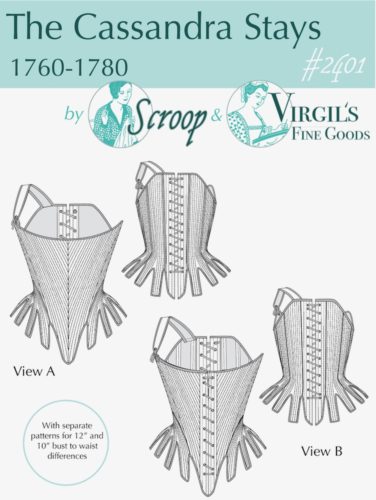

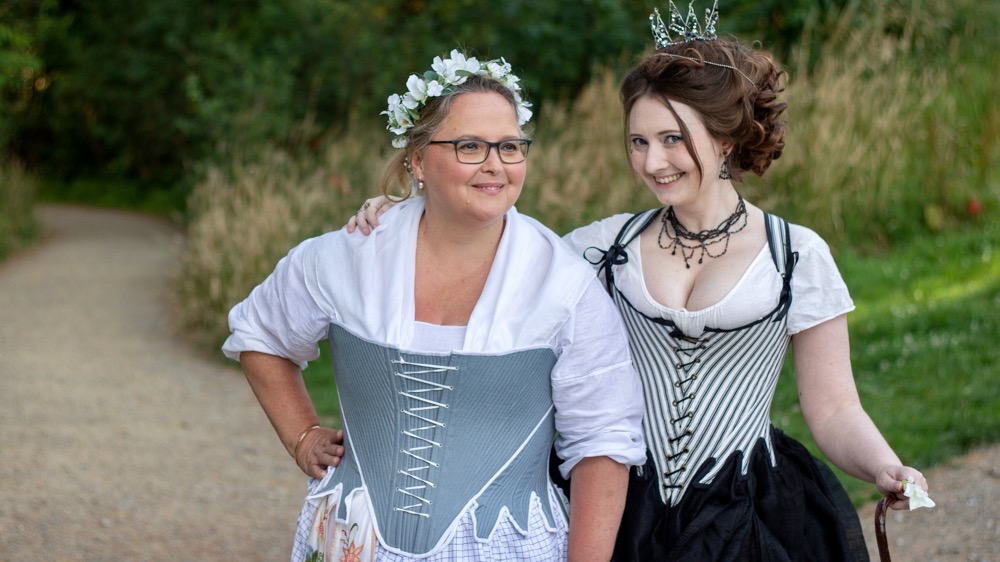


If I have to move the strap point over & redraw it, how should I adjust the boning channels? Does the one to the left of the strap point need to be exactly at the outer bottom edge or can it be one or two boning channels over? What width should the strap area be & how far apart from the long boning channel should the one on the other side of the strap point be? How important is the angle & length at which the two meet?
If you move the strap point over it looks better if you adapt the boning layout so the two different angles of bones meet just beyond the point, but it doesn’t matter if you don’t want to do this. It can absolutely be 1-2 boning channels over. The strap area should be whatever works for your body: there is no rule for that in 18th century staymaking. There are a lot of options for angle and length at which the two meet in extant stays, so however you need to adapt them so it all works for your body is fine.